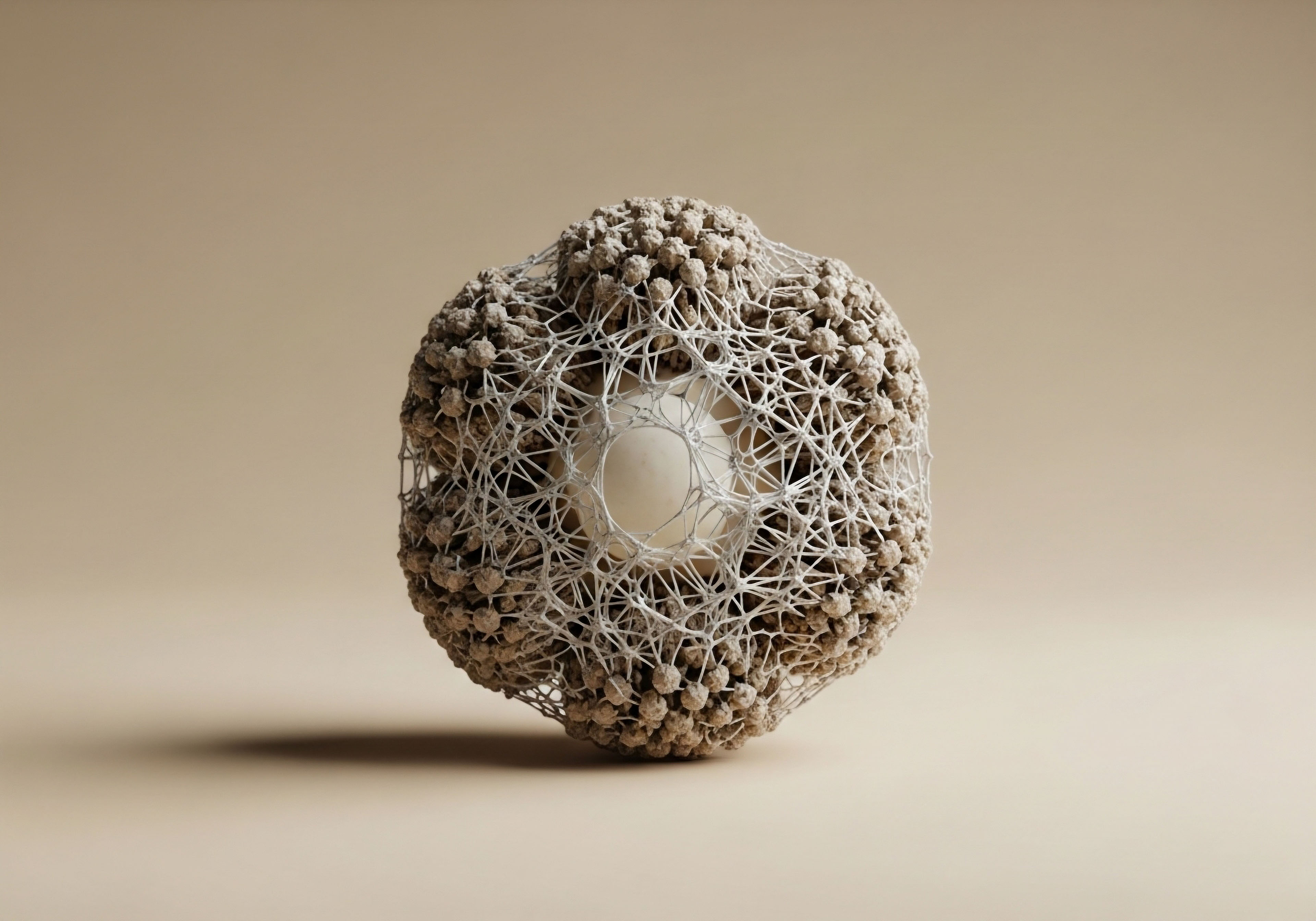

Fundamentals
The experience of initiating a hormonal optimization protocol is deeply personal. It begins with a set of symptoms, a feeling that your internal calibration is off, and a desire to reclaim a state of vitality that feels lost.
When you embark on this path, the appearance of side effects can feel like a setback, a confusing signal from a body you are trying to understand. These effects, whether they manifest as skin changes, shifts in mood, or fluid retention, are your body’s biological response to a new set of instructions.
They are data points in a complex recalibration process. Understanding these signals is the first step toward managing them, transforming them from points of concern into opportunities for refinement and deeper bodily awareness.
Your endocrine system operates as a vast, interconnected communication network. Hormones are the messengers, traveling through the bloodstream to deliver precise instructions to cells and organs, governing everything from your energy levels and metabolic rate to your mood and cognitive function. This system is designed to maintain a dynamic equilibrium, a state known as homeostasis.
When you introduce an external hormone, such as testosterone or progesterone, you are adding a powerful new voice to this intricate conversation. The initial side effects are often the result of the entire network adjusting to this new input. Think of it as an orchestra tuning itself.
Before the symphony can play in perfect harmony, there is a period of adjustment where individual sections find their pitch and volume relative to the others. Your body is doing something similar, recalibrating its internal feedback loops to integrate the new therapeutic messengers.
Managing hormonal therapy side effects begins with interpreting them as biological feedback from a system undergoing recalibration.
The goal of managing these effects is to guide this recalibration process with precision and care. It involves working with the body’s innate intelligence, providing the support it needs to find a new, more optimal equilibrium. This process requires a partnership between you and your clinical guide, using your subjective experience and objective lab data to make informed adjustments.
A sophisticated approach looks beyond the immediate symptom and asks what it reveals about the underlying systemic response. This perspective transforms the management of side effects from a simple reaction into a proactive, empowering part of your journey toward sustained wellness and function.

The Core Messengers in Your System
To navigate this journey, it is essential to understand the primary messengers involved in hormonal optimization protocols and why their balance is so fundamental to your well-being. These hormones function within a delicate, interconnected web, where the level of one profoundly influences the actions of others.

Testosterone a Foundational Hormone for All
Testosterone is a primary steroid hormone active in both male and female physiology. In men, it is the principal androgen, responsible for the development of primary and secondary sexual characteristics, but its role extends far beyond that. It is a key regulator of muscle mass, bone density, red blood cell production, mood, and cognitive function.
When levels decline, men often experience fatigue, loss of muscle, increased body fat, and a decline in libido and mental clarity. The purpose of Testosterone Replacement Therapy (TRT) is to restore this hormone to a functional, youthful range, thereby reversing these symptoms.
In women, testosterone is produced in smaller amounts by the ovaries and adrenal glands, yet it plays a vital role in libido, bone health, muscle integrity, and overall energy. As women approach perimenopause and menopause, testosterone levels decline alongside estrogen and progesterone.
Supplementing with low-dose testosterone can be a critical component of a comprehensive hormonal protocol, helping to restore sexual function, improve mood, and maintain physical strength. The management of side effects in both men and women often involves understanding how the administered testosterone is interacting with other hormonal pathways.

Estrogen the Architect of Growth and Function
Estrogen, primarily estradiol in the context of hormonal health, is often considered the main female sex hormone, but it is critically important for men as well. In women, estrogen governs the menstrual cycle, supports bone density, maintains skin elasticity, and influences mood and cognitive health. The symptoms of menopause, such as hot flashes, vaginal dryness, and mood swings, are direct consequences of declining estrogen levels.
In men, estrogen is produced through the conversion of testosterone by an enzyme called aromatase. It is essential for modulating libido, supporting erectile function, and preserving bone mineral density. Side effects during TRT in men, such as fluid retention or gynecomastia (the development of breast tissue), are typically a result of an imbalance between testosterone and its conversion to estrogen. Effective management, therefore, requires monitoring and controlling this conversion process to maintain an optimal testosterone-to-estrogen ratio.

Progesterone the Great Balancer
Progesterone is a key hormone in the female reproductive cycle, preparing the uterine lining for pregnancy and stabilizing the menstrual cycle. In the context of hormone replacement therapy for women, its most critical role is to protect the uterus. When a woman with a uterus takes estrogen, the uterine lining can thicken, which increases the risk of endometrial cancer.
Progesterone balances estrogen’s proliferative effect, causing the lining to shed and thus providing essential protection. Beyond this, progesterone has calming, anti-anxiety effects and can significantly improve sleep quality. Side effects associated with progesterone, such as drowsiness or mood changes, can often be managed by adjusting the dosage, timing, or type of progesterone used, with micronized progesterone often being better tolerated.


Intermediate
Advancing from a foundational understanding of hormones to the practical management of side effects requires a shift in perspective. Here, we move into the clinical mechanics of hormonal optimization, examining how specific protocols are designed to anticipate and mitigate common adverse effects. The core principle is proactive, intelligent management.
This involves using adjunctive medications and precise dosing strategies to maintain systemic balance, ensuring that the therapeutic benefits of hormonal support are fully realized without being compromised by manageable biological responses. Each protocol is a system of checks and balances, designed to support the body’s complex feedback loops.

Managing Side Effects in Male Protocols
For men undergoing Testosterone Replacement Therapy (TRT), the most common side effects arise from two primary physiological responses ∞ the conversion of testosterone to estradiol and the stimulation of red blood cell production. A well-designed TRT protocol accounts for these eventualities from the outset, incorporating agents that modulate these pathways and a monitoring schedule to track their effects.

Controlling Estrogen Conversion with Aromatase Inhibitors
When exogenous testosterone is introduced, the body’s natural enzymatic processes continue to function. The aromatase enzyme, present in fat tissue, the brain, and other areas, converts a portion of this new testosterone into estradiol. While a certain level of estradiol is crucial for male health, an excessive conversion rate can lead to an elevated level of this estrogen, causing undesirable side effects. These include:
- Gynecomastia This is the development of glandular breast tissue, often accompanied by tenderness or sensitivity. It occurs when the ratio of estrogen to androgen in breast tissue shifts too far in favor of estrogen, stimulating tissue growth.
- Fluid Retention Elevated estradiol can cause the body to retain sodium and water, leading to bloating, swelling in the ankles, and a potential increase in blood pressure.
- Mood Swings A significant imbalance between testosterone and estradiol can contribute to emotional lability and irritability.
To manage these effects, clinical protocols often include an Aromatase Inhibitor (AI) such as Anastrozole. Anastrozole works by blocking the aromatase enzyme, thereby reducing the conversion of testosterone to estradiol. It is typically prescribed as a low-dose oral tablet taken twice weekly.
The goal is not to eliminate estrogen but to control it, maintaining a healthy, functional balance. Regular blood work is essential to monitor estradiol levels and adjust the Anastrozole dosage, ensuring that levels do not become too high or, conversely, too low, which can negatively impact libido and bone health.

Preserving Testicular Function with Gonadorelin
The human endocrine system operates on a sophisticated negative feedback mechanism known as the Hypothalamic-Pituitary-Gonadal (HPG) axis. The hypothalamus produces Gonadotropin-Releasing Hormone (GnRH), which signals the pituitary gland to release Luteinizing Hormone (LH) and Follicle-Stimulating Hormone (FSH). LH then travels to the testes, instructing the Leydig cells to produce testosterone.
When the body detects sufficient testosterone levels, as is the case during TRT, it signals the hypothalamus and pituitary to decrease their output of GnRH, LH, and FSH.
This shutdown of the HPG axis leads to a cessation of the body’s natural testosterone production and can cause testicular atrophy, or shrinkage, as well as a reduction in fertility. To counteract this, protocols include a GnRH analog called Gonadorelin. Gonadorelin is a synthetic version of the hormone released by the hypothalamus.
By administering it via subcutaneous injection, it directly stimulates the pituitary gland to continue releasing LH and FSH, bypassing the suppressed signal from the hypothalamus. This action keeps the testes active, preserving their size and function and maintaining a degree of natural testosterone production and spermatogenesis. This is a prime example of working with the body’s systems to maintain function during a therapeutic intervention.

What Is the Protocol for Managing Erythrocytosis?
One of the most significant potential side effects of TRT is erythrocytosis, an increase in the concentration of red blood cells, measured by hematocrit and hemoglobin levels. Testosterone stimulates erythropoiesis (red blood cell production) partly by increasing the production of the hormone erythropoietin (EPO) from the kidneys and by suppressing hepcidin, a protein that regulates iron availability.
While this can enhance oxygen-carrying capacity, an excessive increase in red blood cell mass thickens the blood, a condition that can elevate the risk of thromboembolic events like stroke or heart attack.
Systematic monitoring of hematocrit levels is a non-negotiable component of safe and effective testosterone therapy.
Management of erythrocytosis is a critical aspect of TRT safety. Clinical guidelines recommend monitoring hematocrit levels at baseline and then periodically throughout treatment. If the hematocrit rises above a certain threshold, typically around 52-54%, intervention is required. The first step is often to adjust the TRT protocol, perhaps by lowering the dose or changing the frequency of injections to create more stable blood levels.
If these adjustments are insufficient, the standard procedure is therapeutic phlebotomy, which is the clinical term for donating blood. By removing a unit of blood, the concentration of red blood cells is immediately reduced, lowering hematocrit to a safer range. This procedure may need to be repeated periodically to maintain hematocrit within an acceptable range, ensuring the cardiovascular benefits of optimized testosterone are not compromised.

Navigating Side Effects in Female Protocols
For women, hormonal therapy typically involves a delicate balance of estrogen, progesterone, and sometimes testosterone. Side effects often relate to the specific hormones used and their dosage. The management strategy focuses on individualizing the protocol to match the patient’s unique physiology and sensitivities.
| Hormone | Common Side Effects | Clinical Management Strategy |
|---|---|---|
| Estrogen | Breast tenderness, bloating, fluid retention, headaches. | Adjusting the dose or changing the delivery method (e.g. from oral to transdermal patch or gel) can create more stable serum levels and reduce side effects. |
| Progesterone | Mood changes (irritability, low mood), drowsiness, bloating, breast tenderness. | Switching from synthetic progestins to body-identical micronized progesterone often reduces side effects. Taking the dose at bedtime can leverage the drowsy effect to improve sleep. Adjusting the dose is also a primary strategy. |
| Testosterone (Low-Dose) | Acne, oily skin, unwanted hair growth (hirsutism), potential mood changes. | Careful dose titration is key. Starting with a very low dose and gradually increasing it allows for assessment of tolerance. Monitoring for symptoms and adjusting the dose downward if androgenic side effects appear is standard practice. |

The Importance of Progesterone Type and Timing
Many of the unwanted side effects women experience on combined HRT are related to the progestogen component. Synthetic progestins, which are chemically different from the progesterone the body produces, can sometimes be associated with negative mood effects, bloating, and acne. A significant advancement in managing these side effects has been the increased use of micronized progesterone. This form is structurally identical to the body’s own progesterone, and for many women, this results in a much better side effect profile.
Furthermore, the timing of progesterone administration can be used to therapeutic advantage. Progesterone can cause drowsiness, which is an undesirable side effect if taken in the morning. However, when taken at bedtime, this same effect becomes a benefit, promoting deeper and more restful sleep, which is often disrupted during menopause. This is a simple yet elegant example of how understanding a hormone’s properties allows for intelligent protocol design that turns a potential side effect into a therapeutic benefit.

How Are Peptide Therapy Side Effects Addressed?
Peptide therapies, such as Sermorelin or Ipamorelin/CJC-1295, are designed to stimulate the body’s own production of growth hormone. They are generally well-tolerated, and their side effects are typically mild and transient. The most common effects include:
- Injection Site Reactions Redness, itching, or mild swelling at the subcutaneous injection site is the most frequent side effect. This is usually a minor, localized immune response that resolves on its own. Rotating injection sites can help minimize this.
- Flushing or Warmth Some individuals experience a temporary feeling of warmth or flushing shortly after injection. This is related to the peptide’s stimulation of the pituitary gland and typically subsides within a few minutes.
- Headaches Mild headaches can occur, especially when beginning therapy, as the body adjusts to changes in hormone release. These are usually temporary and can be managed with hydration and, if necessary, standard analgesics.
Because these peptides work by enhancing the body’s natural pulsatile release of growth hormone, they are considered a more physiological approach than direct administration of synthetic HGH. This mechanism inherently reduces the risk of more severe side effects associated with supraphysiological growth hormone levels. Management is primarily about patient education, reassuring individuals that these mild, transient effects are a normal part of the initial adaptation period and typically diminish as the body acclimates to the therapy.


Academic
A sophisticated approach to managing the side effects of hormonal therapy requires a deep, mechanistic understanding of the underlying pathophysiology. We must move beyond simple symptom correlation and into the realm of systems biology, where a single therapeutic input can trigger a cascade of interconnected molecular events.
The phenomenon of testosterone-induced erythrocytosis provides a compelling case study for this level of analysis. It is a predictable and clinically significant adverse effect of TRT that sits at the intersection of endocrinology, hematology, and cardiovascular medicine. Examining its biological basis reveals the intricate web of signaling pathways that testosterone modulates, offering profound insight into why this effect occurs and how it can be managed with precision.

The Molecular Pathophysiology of Testosterone-Induced Erythrocytosis
Testosterone’s effect on red blood cell production is a complex, multi-pronged mechanism that goes far beyond a simple stimulatory signal. It involves the coordinated regulation of hormonal signals, iron metabolism, and hematopoietic stem cell activity. The primary drivers of this process can be dissected into several key pathways.

Direct and Indirect Stimulation of Erythropoietin (EPO)
Erythropoietin is the principal hormone regulating red blood cell production. Produced primarily by the kidneys in response to tissue hypoxia (low oxygen levels), EPO travels to the bone marrow and stimulates the proliferation and differentiation of erythroid progenitor cells. Testosterone amplifies this system in several ways.
While some evidence suggests a direct stimulatory effect on EPO gene transcription in the kidneys, a more established mechanism involves testosterone’s influence on hypoxia-inducible factors (HIFs). HIFs are transcription factors that are stabilized under low-oxygen conditions and are central to the body’s adaptive response to hypoxia, which includes upregulating EPO.
Testosterone appears to enhance the stability and activity of the HIF pathway, effectively lowering the threshold for EPO release and establishing a new, higher set point for the EPO-hemoglobin axis. This means that for any given level of tissue oxygenation, a testosterone-replete system will produce more EPO than a deficient one.

Suppression of Hepcidin and the Role of Iron Bioavailability
A pivotal and perhaps equally important mechanism is testosterone’s profound effect on iron metabolism via the suppression of hepcidin. Hepcidin is a peptide hormone produced by the liver that acts as the master regulator of systemic iron homeostasis. It functions by binding to ferroportin, the only known cellular iron exporter, causing its internalization and degradation.
This action traps iron within cells (like absorptive enterocytes and storage macrophages), preventing its entry into the bloodstream. High hepcidin levels restrict iron availability for erythropoiesis.
Testosterone administration has been shown to directly suppress hepcidin production. The precise molecular link is still under investigation but appears to be independent of inflammatory pathways. By lowering hepcidin levels, testosterone increases ferroportin expression on cell surfaces, leading to a greater efflux of iron into the circulation.
This sustained increase in iron bioavailability provides the essential substrate needed for the bone marrow to synthesize hemoglobin for new red blood cells. This concurrent action ∞ stimulating EPO while also ensuring the raw materials are available ∞ creates a powerful, synergistic drive for erythropoiesis. This dual impact explains why the effect of testosterone on hematocrit can be so pronounced.
| Biological Pathway | Molecular Action of Testosterone | Physiological Consequence |
|---|---|---|
| Renal EPO Production | Enhances stability and activity of Hypoxia-Inducible Factors (HIFs), leading to increased EPO gene transcription. | Elevated circulating EPO levels, which directly stimulate bone marrow. |
| Iron Homeostasis | Directly suppresses hepatic expression of the hepcidin gene. | Reduced hepcidin levels lead to increased ferroportin activity, enhancing iron absorption and mobilization from stores. |
| Bone Marrow Activity | Promotes the differentiation of hematopoietic stem cells into the erythroid lineage and may increase the sensitivity of erythroid precursors to EPO. | Accelerated proliferation and maturation of red blood cell precursors within the bone marrow. |

Why Do Different Formulations Carry Different Risks?
The incidence and severity of erythrocytosis are not uniform across all TRT modalities. Clinical data consistently show that intramuscular injections of testosterone esters (like cypionate or enanthate) are associated with a higher risk of developing erythrocytosis compared to transdermal gels or creams. This difference is rooted in the pharmacokinetics of the delivery system.
Intramuscular injections create a depot of testosterone that is released over time, leading to initial supraphysiological peaks in serum testosterone levels shortly after administration. These high peaks provide a powerful, albeit temporary, stimulus to the erythropoietic pathways.
Even though levels trough before the next injection, this cyclical exposure to very high concentrations of testosterone appears to be a more potent driver of red blood cell production than the relatively stable, physiological levels maintained by daily transdermal applications. This pharmacokinetic variance underscores the importance of protocol selection and its direct impact on the risk profile of the therapy.
The choice of testosterone delivery system is a key determinant of the pharmacokinetic profile, which in turn directly influences the risk of erythrocytosis.

Clinical Implications and the Phlebotomy Debate
The clinical concern surrounding erythrocytosis is its potential to increase blood viscosity, which is linked to an elevated risk of venous thromboembolism (VTE) and other cardiovascular events. While this association is well-established in the context of myeloproliferative neoplasms like polycythemia vera, the absolute risk conferred by TRT-induced secondary erythrocytosis is less clear and a subject of ongoing research.
Nonetheless, clinical guidelines from major endocrine societies advocate for discontinuing or reducing TRT if hematocrit exceeds a threshold of 54%, with therapeutic phlebotomy recommended as a management tool.
However, the recommendation for phlebotomy is not without its own physiological complexities. Phlebotomy effectively reduces hematocrit, but it does so at the cost of depleting the body’s iron stores. Chronic phlebotomy can induce a state of iron deficiency.
This iron deficiency, combined with the transient tissue hypoxia that may follow blood removal, could theoretically create a counter-regulatory stimulus for the HIF pathway, potentially creating a pro-thrombotic state even as hematocrit is lowered. This highlights a potential paradox in the standard management approach.
The decision to initiate therapeutic phlebotomy should therefore involve a careful consideration of the patient’s individual cardiovascular risk profile, the degree of hematocrit elevation, and an understanding of these competing physiological signals. Shared decision-making, where the potential benefits of reducing blood viscosity are weighed against the potential consequences of iron depletion, is paramount.
This deep dive into the mechanisms of a single side effect reveals the complexity of hormonal therapy. Effective and safe management is predicated on this level of understanding. It allows the clinician to move from a reactive posture to a proactive one, anticipating effects based on protocol choices, monitoring the relevant biomarkers with purpose, and making interventions that are grounded in a sophisticated appreciation of human physiology.

References
- de Ronde, W. and F. M. de Hon. “Aromatase inhibitors in men ∞ effects and therapeutic options.” Reproductive Biology and Endocrinology, vol. 9, no. 1, 2011, p. 93.
- Jones, T. H. “Management of adverse effects in testosterone replacement therapy.” Asian Journal of Andrology, vol. 17, no. 2, 2015, pp. 215-220.
- Nassar, G. N. and S. R. Leslie. “Physiology, Testosterone.” StatPearls, StatPearls Publishing, 2023.
- Bhasin, S. et al. “Testosterone Therapy in Men With Hypogonadism ∞ An Endocrine Society Clinical Practice Guideline.” The Journal of Clinical Endocrinology & Metabolism, vol. 103, no. 5, 2018, pp. 1715 ∞ 1744.
- Kacker, R. et al. “Estrogens in men ∞ a clinical review.” The Journal of Clinical Endocrinology & Metabolism, vol. 99, no. 10, 2014, pp. 3525-46.
- Ohlander, S. J. et al. “Erythrocytosis Following Testosterone Therapy.” Sexual Medicine Reviews, vol. 6, no. 1, 2018, pp. 77-85.
- Stuenkel, C. A. et al. “Treatment of Symptoms of the Menopause ∞ An Endocrine Society Clinical Practice Guideline.” The Journal of Clinical Endocrinology & Metabolism, vol. 100, no. 11, 2015, pp. 3975 ∞ 4011.
- Garnick, M. B. “Testosterone Replacement Therapy and Cardiovascular Risk.” The New England Journal of Medicine, vol. 372, no. 8, 2015, pp. 775-7.
- Anaissie, J. et al. “Testosterone therapy-induced erythrocytosis ∞ can phlebotomy be justified?.” Endocrine Connections, vol. 11, no. 1, 2022, e210499.
- Hudson, J. et al. “Adverse cardiovascular events and mortality in men during testosterone treatment ∞ an individual patient and aggregate data meta-analysis.” The Lancet Healthy Longevity, vol. 3, no. 6, 2022, pp. e381-e393.

Reflection

Calibrating Your Internal Landscape
The information presented here provides a map of the biological terrain you are navigating. It details the mechanisms, the protocols, and the clinical strategies involved in guiding your body toward a new state of hormonal balance. This knowledge is a powerful tool, transforming what might feel like a series of abstract symptoms and interventions into a coherent, understandable process.
It is the foundation upon which you can build a more intuitive relationship with your own physiology, learning to listen to its signals with clarity and confidence.
Your personal health journey is unique. The way your body responds to a therapeutic protocol is the result of your distinct genetic makeup, your lifestyle, and your history. The path forward involves taking this objective, scientific knowledge and integrating it with your own subjective experience.
The goal is to arrive at a place of empowered collaboration, where you and your clinical guide work together to fine-tune your protocol, making precise adjustments that honor the feedback your body provides. This process is one of continual learning and refinement, a journey of discovery into the intricate workings of your own internal world. The ultimate aim is to achieve a state of function and vitality that allows you to live fully, without compromise.


